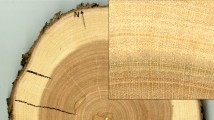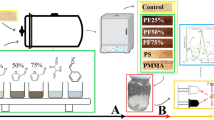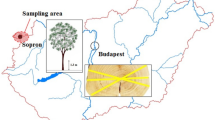Abstract
This study was the first attempt to investigate pyrolysis of suppressed and healthy Scots pine (Pinus Sylvestris Ledeb.) wood growing in Central Siberia (the forest-steppe zone of Krasnoyarsk Region) using thermogravimetric analysis coupled with Fourier transform infrared spectroscopy (TG-FTIR). To describe the post-pyrolysis parameters of lignin and cellulose molecular structure, the method of pyrolytic gas chromatography-mass spectrometry (Py-GC/MS) was applied. A combination of integrated TG-FTIR method with Py-GC/MS applied for studying the wood of suppressed Scots pine allowed us to take a new look at rot-induced changes of the wood chemical composition. The results obtained by TG-FTIR method and by Py-GC/MS method are in good agreement with each other, showing that rot fungi cause the depletion of the aromatic component in the wood of suppressed Scots pine. A detailed study of the holocellulose fraction revealed an increase in the relative content of cyclopentenones, sugars, and a decrease in the relative content of furans in samples of the wood of suppressed Scots pine. It has been established that benzenes, phenols, guaiacyl lignin fragments, and syringyl lignin fragments are destroyed in samples of suppressed trees when exposed to a fungal infection. The use of these methods will help to identify trees affected by a fungal infection at an early stage that cannot be determined visually.





Similar content being viewed by others
References
Schwarze FWMR, Engels J, Mattheck C. Fungal strategies of wood decay in trees. Springer-Verlag, Berlin, Heidelberg; 2000.
Moreth U, Schmidt O. Investigation on ribosomal DNA of indoor wood decay fungi for their characterization and identification. Holzforsch. 2005;59:90–3. https://doi.org/10.1515/HF.2005.014.
Kim G-H, Kim J-J, Lim YW, Breuil C. Ophiostomatoid fungi isolated from Pinus radiata logs imported from New Zealand to Korea. Can J Bot. 2005;83:272–8. https://doi.org/10.1139/b04-170.
Jasalavich CA, Ostrofsky A, Jellison J. Detection and identification of decay fungi in spruce wood by restriction fragment length polymorphism analysis of amplified genes encoding rRNA. Appl Environ Microbiol. 2000;66:4725–34. https://doi.org/10.1128/AEM.66.11.4725-4734.2000.
Bahnweg G, Schulze S, Möller EM, Rosenbrock H, Langebartels C, Sandermann H. DNA isolation from recalcitrant materials such as tree roots, bark, and forest soil for the detection of fungal pathogens by polymerase chain reaction. Anal Biochem. 1998;262:79–82. https://doi.org/10.1006/abio.1998.2769.
Girometta C, Dondi D, Baiguera RM, Bracco F, Branciforti DS, Buratti S, Savino E. Characterization of mycelia from wood-decay species by TGA and IR spectroscopy. Cellulose. 2020;27:6133–48. https://doi.org/10.1007/s10570-020-03208-4.
Salman A, Tsror L, Pomerantz A, Morehc R, Mordechai S, Huleihel M. FTIR spectroscopy for detection and identification of fungal phytopathogenes. Spectroscopy. 2010;24:261–7. https://doi.org/10.3233/SPE-2010-0448.
Gupta BS, Bjørn Jelle BP, Gao T. Application of ATR-FTIR spectroscopy to compare the cell materials of wood decay fungi with wood mould fungin. Int J Spectrosc. 2015. https://doi.org/10.1155/2015/521938.
Shakir AM, Azahari B, Yusup Y, Yhaya MF, Salehabadi A, Ahmad MI. Preparation and characterization of mycelium as a bio-matrix in fabrication of bio-composite. J Adv Res Fluid Mech Therm Sci. 2020;65:1–11.
Drevin I, Bo-L J, Son EL. Pyrolysis in biotechnology. Biotechnol Genet Eng Rev. 2013;81(7):3–28. https://doi.org/10.1080/02648725.2001.10648006.
Furuhashi T, Beran A, Blazso M, Czegeny Z, Schwarzinger C, Steiner G. Pyrolysis GC/MS and IR spectroscopy in chitin analysis of molluscan shells. Biosci Biotechnol Biochem. 2009;73(1):93–103. https://doi.org/10.1271/bbb.80498.
Loskutov SR, Shapchenkova OA, Petrunina EA, Plyashechnik MA, Tyutkova EA, Pashenova NV, Grodnitskaya BD, Aniskina AA, Senashova VA. Diagnostics of early changes in the physicochemical properties of wood under the influence of fungal infections. Chem Plant Raw Mater. 2022;2:61–72. https://doi.org/10.14258/jcprm.2022029801.
Jiang L, Walczyk D, McIntyre G. Chan WK cost modeling and optimization of a manufacturing system for mycelium-based biocomposite parts. J Manuf Syst. 2016;41:8–20. https://doi.org/10.1016/j.jmsy.2016.07.004.
Okisheva NP, Shumilova ND, Kiseleva PA. Agro-climatic guide for the Krasnoyarsk territory and Tuva autonomous region. Leningrad: Gidrometeoizdat; 1974.
Boboleva EE. On the characteristics of the soil cover of the Pogorelsk station. Res For Sib. 1968;1:33–8.
Gao N, Li A, Quan C, Du L, Duan Y. TG–FTIR and Py–GC/MS analysis on pyrolysis and combustion of pine sawdust. J Anal Appl Pyrolysis. 2013;100:26–32. https://doi.org/10.1016/j.jaap.2012.11.009.
Shen DK, Gu S, Bridgwater AV. Study on the pyrolytic behaviour of xylan-based hemicellulose using TG–FTIR and Py–GC–FTIR. J Anal Appl Pyrolysis. 2010;87:199–206. https://doi.org/10.1016/j.jaap.2009.12.001.
Tamburini D, Łucejko JJ, Zborowska M, Modugno F, Prądzyński W, Colombini MP. Archaeological wood degradation at the site of Biskupin (Poland): wet chemical analysis and evaluation of specific Py-GC/MS profiles. J Anal Appl Pyrolysis. 2015;115:7–15. https://doi.org/10.1016/j.jaap.2015.06.005.
Braovac S, Tamburini D, Lucejko JJ, McQueen C, Kutzke H, Colombini M. Chemical analyses of extremely degraded wood using analytical pyrolysis and inductively coupled plasma atomic emission spectroscopy. Microchem J. 2016;124(256):368–79. https://doi.org/10.1016/j.microc.2015.09.016.
Ulloa CA, Gordon AL, García XA. Thermogravimetric study of interactions in the pyrolysis of blends of coal with radiata pine sawdust. Fuel Process Technol. 2009;90:583–90. https://doi.org/10.1016/j.fuproc.2008.12.015.
Brischke C, Alfredsen G. Wood-water relationships and their role for wood susceptibility to fungal decay. Appl Microbiol Biotechnol. 2020;104:3781–95. https://doi.org/10.1007/s00253-020-10479-1.
Blanchette RA. Delignification by wood-decay fungi. Ann Rev Phytopathol. 1991;29:381–98. https://doi.org/10.1146/annurev.py.29.090191.002121.
Babiński L, Zborowska M, Fabisiak E, Prądzyński W. Are the wooden remains of the Lusatian culture settlement at Biskupin safe? Decomposition of archaeological oak wood samples during a 10 year experiment. Archaeol Anthropol Sci. 2019;11:6583–94. https://doi.org/10.1007/s12520-019-00926-0.
Giachi G, Bettazzi F, Chimichi S, Staccioli G. Chemical characterisation of degraded wood in ships discovered in a recent excavation of the Etruscan and Roman harbour of Pisa. J Cult Herit. 2003;4:75–83. https://doi.org/10.1016/S1296-2074(03)00018-9.
Moldoveanu SC. Analytical pyrolysis of natural organic polymers. Amsterdam: Elsevier Science; 1998.
Pouwels AD, Eijkel GB, Boon JJ. Curie-point pyrolysis capillary gas chromatography-high-resolution mass. J Anal Appl Pyrolysis. 1989;14(4):237–80. https://doi.org/10.1016/0165-2370(89)80003-8.
Ramirez-Corredores MM. Pathways and mechanisms of fast pyrolysis: impact on catalyst research. In: Triantafyllidis K, Lappas A, Stöcker M, editors. The role of catalysis for the sustainable production of bio-fuels and biochemicals. Amsterdam: Elsevier; 2013. pp. 161–2016. https://doi.org/10.1016/B978-0-444-56330-9.00006-1.
Pedersen NB, Łucejko JJ, Modugno F, Björdal C. Correlation between bacterial decay and chemical changes in waterlogged archaeological wood analysed by light microscopy and Py-GC/MS. Holzforsch. 2021;75(7):635–45. https://doi.org/10.1515/hf-2020-0153.
Kirk TK, Farrel RL. Enzymatic “combustion”: the microbial degradation of lignin. Ann Rev Microbiol. 1987;41:465–505. https://doi.org/10.1146/annurev.mi.41.100187.002341.
Filley TR, Cody GD, Goodell B, Jellison J, Noser C, Ostrofsky A. Lignin demethylation and polysaccharide decomposition in spruce sapwood degraded by brown rot fungi. Org Geochem. 2002;33(2):111–24. https://doi.org/10.1016/S0146-6380(01)00144-9.
Funding
Funding was provided by Russian Science Foundation project “Strategy for adaptive forest management of the Siberian boreal forests under global change” (№ 21-46-07002).
Author information
Authors and Affiliations
Corresponding author
Additional information
Publisher's Note
Springer Nature remains neutral with regard to jurisdictional claims in published maps and institutional affiliations.
Rights and permissions
Springer Nature or its licensor (e.g. a society or other partner) holds exclusive rights to this article under a publishing agreement with the author(s) or other rightsholder(s); author self-archiving of the accepted manuscript version of this article is solely governed by the terms of such publishing agreement and applicable law.
About this article
Cite this article
Tyutkova, E., Loskutov, S., Dorzhiev, D. et al. Physical and chemical wood characteristics of healthy vs. suppressed Scots pine trees of Central Siberia. J Therm Anal Calorim 148, 11743–11752 (2023). https://doi.org/10.1007/s10973-023-12496-4
Received:
Accepted:
Published:
Issue Date:
DOI: https://doi.org/10.1007/s10973-023-12496-4




